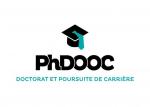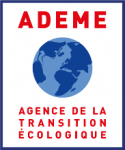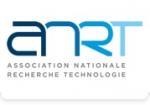Ingénierie des super-réseaux ferroélectriques pour le contrôle de la conductivité thermique // Ferroelectric superlattice engineering for tunable thermal conductivity
|
ABG-133657
ADUM-67620 |
Sujet de Thèse | |
| 02/10/2025 | Autre financement public |
Université de Picardie - Jules Verne
Amiens - Les Hauts de France - France
Ingénierie des super-réseaux ferroélectriques pour le contrôle de la conductivité thermique // Ferroelectric superlattice engineering for tunable thermal conductivity
- Physique
Ferroélectriques, Croissance couches minces, nanodomaines, conductivité thermique, Propriétés structurales, Propriétés électriques
Ferroelectrics, thin films growth, nanodomaines, thermal conductivity, Structural properties, Electrical properties
Ferroelectrics, thin films growth, nanodomaines, thermal conductivity, Structural properties, Electrical properties
Description du sujet
La manipulation des phonons (flux de chaleur) est cruciale pour minimiser les pertes de chaleur dans les circuits électroniques, réaliser des technologies de réfrigération à l'état solide à haut rendement, convertir l'énergie thermoélectrique, et contribuer à un futur type d'informatique basé sur les courants thermiques. L'objectif de ce sujet de recherche, qui s'inscrit dans l'ANR SUPER, est de développer des super-réseaux ferroélectriques présentant des propriétés originales de transport des phonons pour contrôler la conductivité thermique via un champ électrique. Les super-réseaux d'oxyde ferroélectrique présentent des structures topologiques exotiques dans les nanocouches tels des parois de domaine et des vortex ferroélectriques. Les parois de domaine possèdent des profils de déformation complexes et interagissent avec les phonons, influençant la conductivité thermique. Outre l'ordre chimique hors plan, l'ordre ferroélectrique hors plan et dans le plan peut être modifié sous champ électrique. L'étude des parois de domaines pour le contrôle du flux de chaleur est un champ de recherche récent, avec de nombreuses questions encore ouvertes. Au cours de la thèse, des super-réseaux d'oxydes ferroélectriques de différentes compositions, épaisseurs et périodes seront élaborés pour générer différents ordres chimiques et ferroélectriques. La thèse se déroulera dans le cadre d'une cotutelle entre l'université de Picardie Jules Verne et l'université de Tours. Les super-réseaux seront élaborés au laboratoire LPMC (université de Picardie Jules Verne) par la technique d'ablation laser, qui permet d'obtenir des super-réseaux d'excellente qualité cristalline. La diffraction d'électrons de haute énergie en incidence rasante, permettra de contrôler in situ la croissance des films. Les propriétés structurales (nature de l'épitaxie, état de contrainte, mosaïcité), les caractéristiques de la structure en domaines ainsi que les transitions de phase seront étudiées par diffraction de rayons X à l'aide d'un diffractomètre haute résolution. L'ordre polaire à l'échelle atomique sera observé par microscopie électronique en transmission à balayage, au laboratoire SPMS (CentraleSupélec – Université Paris-Saclay), partenaire du consortium SUPER. La dynamique de basculement des domaines dans les super-réseaux ferroélectriques sera étudiée au laboratoire GREMAN (Université de Tours). Les caractérisations électriques seront réalisées à l'aide de la microscopie à force atomique en mode piézoréponse, de la spectroscopie d'impédance en fonction de la température et du champ électrique appliqué. Des mesures ferroélectriques classiques (P(E), C(V)), complèteront l'étude. La conductivité thermique et les interactions entre parois de domaines et phonons, seront étudiés au laboratoire LOMA (Université de Bordeaux), partenaire de l'ANR SUPER, en collaboration avec le laboratoire GREMAN. Ce travail de recherche s'inscrit dans le cadre d'une approche multidisciplinaire combinant la science des matériaux, axée sur le contrôle des nanodomaines ferroélectriques, avec la physique de la matière condensée, où conductivité thermique et dynamique des phonons seront étudiées. Les caractérisations multi-échelles (nanométrique au macroscopique) et mesures in-operando sous champ électrique.
------------------------------------------------------------------------------------------------------------------------------------------------------------------------
------------------------------------------------------------------------------------------------------------------------------------------------------------------------
Manipulating phonons (heat flows) is critical for minimizing heat losses in electronic circuits, achieving high-efficiency solid-state refrigeration technologies and thermoelectric energy conversion, and promising for new type of computing based on thermal currents rather than electric currents. The objective of the PhD thesis, which is part of the ANR SUPER, is to develop ferroelectric superlattices exhibiting new phonon transport properties to tune thermal conductivity on-demand with the application of an electric-field. Ferroelectric oxide superlattices present exotic topological structures within the nanolayers, such as ferroelectric domain walls and vortices. Domain walls possess complex strain profiles and interact with phonons and thus influence the thermal conductivity. In addition to the out-of-plane chemical order, there is an out-of-plane and in-plane nanoscale ferroelectric order that can be interestingly modified by applying an electric field. The use of domain walls to control heat flow is a new area of research, in which most questions remain open. In this PhD thesis, epitaxial ferroelectric oxides superlattices with different chemistries, thicknesses and periods, will be built to generate different controlled chemical and ferroelectric orders. This PhD will be conducted under a cotutelle agreement between the university of Picardie Jules Verne and the university of Tours. The superlattices will be grown at the LPMC laboratory (University of Picardie Jules Verne), by pulsed laser deposition a technique easily applicable for the growth of high quality superlattices. High-energy electron diffraction will be used to monitor the growth of the films. The structural properties (crystalline strain structure and strain state), the characteristics of the domain structure as well as the phase transition will be investigated by X-ray diffraction using a high resolution diffractometer. The polar order at atomic scale will be probed using scanning transmission electron microscope at the SPMS laboratory (CentraleSupélec – University Paris-Saclay), partner of the ANR project. The dynamic of domain switching in ferroelectric superlattices will be studied at the GREMAN laboratory (University of Tours). Electrical characterizations will be performed on the superlattices, using piezoresponse force microscopy, impedance spectroscopy as a function of temperature and electric-field. Conventional ferroelectric measurement methods such as P(E), C(V) will also be performed. The thermal conductivity and phonon-domain walls interactions in ferroelectric superlattices will be investigated at the LOMA laboratory (University of Bordeaux), partner of the ANR project, in collaboration with the GREMAN laboratory. This thesis project is planned as part of a multidisciplinary approach which will combine materials science, focusing on the control of ferroelectric nanodomains in superlattices, with condensed matter physics, where thermal conductivity and phonon dynamics will be investigated. It includes multi-scale characterizations (nanoscale to macroscale) with in-operando measurements under electric-field.
------------------------------------------------------------------------------------------------------------------------------------------------------------------------
------------------------------------------------------------------------------------------------------------------------------------------------------------------------
Début de la thèse : 10/11/2025
------------------------------------------------------------------------------------------------------------------------------------------------------------------------
------------------------------------------------------------------------------------------------------------------------------------------------------------------------
Manipulating phonons (heat flows) is critical for minimizing heat losses in electronic circuits, achieving high-efficiency solid-state refrigeration technologies and thermoelectric energy conversion, and promising for new type of computing based on thermal currents rather than electric currents. The objective of the PhD thesis, which is part of the ANR SUPER, is to develop ferroelectric superlattices exhibiting new phonon transport properties to tune thermal conductivity on-demand with the application of an electric-field. Ferroelectric oxide superlattices present exotic topological structures within the nanolayers, such as ferroelectric domain walls and vortices. Domain walls possess complex strain profiles and interact with phonons and thus influence the thermal conductivity. In addition to the out-of-plane chemical order, there is an out-of-plane and in-plane nanoscale ferroelectric order that can be interestingly modified by applying an electric field. The use of domain walls to control heat flow is a new area of research, in which most questions remain open. In this PhD thesis, epitaxial ferroelectric oxides superlattices with different chemistries, thicknesses and periods, will be built to generate different controlled chemical and ferroelectric orders. This PhD will be conducted under a cotutelle agreement between the university of Picardie Jules Verne and the university of Tours. The superlattices will be grown at the LPMC laboratory (University of Picardie Jules Verne), by pulsed laser deposition a technique easily applicable for the growth of high quality superlattices. High-energy electron diffraction will be used to monitor the growth of the films. The structural properties (crystalline strain structure and strain state), the characteristics of the domain structure as well as the phase transition will be investigated by X-ray diffraction using a high resolution diffractometer. The polar order at atomic scale will be probed using scanning transmission electron microscope at the SPMS laboratory (CentraleSupélec – University Paris-Saclay), partner of the ANR project. The dynamic of domain switching in ferroelectric superlattices will be studied at the GREMAN laboratory (University of Tours). Electrical characterizations will be performed on the superlattices, using piezoresponse force microscopy, impedance spectroscopy as a function of temperature and electric-field. Conventional ferroelectric measurement methods such as P(E), C(V) will also be performed. The thermal conductivity and phonon-domain walls interactions in ferroelectric superlattices will be investigated at the LOMA laboratory (University of Bordeaux), partner of the ANR project, in collaboration with the GREMAN laboratory. This thesis project is planned as part of a multidisciplinary approach which will combine materials science, focusing on the control of ferroelectric nanodomains in superlattices, with condensed matter physics, where thermal conductivity and phonon dynamics will be investigated. It includes multi-scale characterizations (nanoscale to macroscale) with in-operando measurements under electric-field.
------------------------------------------------------------------------------------------------------------------------------------------------------------------------
------------------------------------------------------------------------------------------------------------------------------------------------------------------------
Début de la thèse : 10/11/2025
Nature du financement
Autre financement public
Précisions sur le financement
ANR Financement d'Agences de financement de la recherche
Présentation établissement et labo d'accueil
Université de Picardie - Jules Verne
Etablissement délivrant le doctorat
Université de Picardie - Jules Verne
Ecole doctorale
585 Sciences, Technologie, Santé
Profil du candidat
Etudiant M2 en sciences des matériaux, nanosciences ou physique de la matière condensée
Student at Master 2 level in material sciences, nanosciences or condensed matter physics
Student at Master 2 level in material sciences, nanosciences or condensed matter physics
15/10/2025
Postuler
Fermer
Vous avez déjà un compte ?
Nouvel utilisateur ?
Besoin d'informations sur l'ABG ?
Vous souhaitez recevoir nos infolettres ?
Découvrez nos adhérents
 Ifremer
Ifremer  ONERA - The French Aerospace Lab
ONERA - The French Aerospace Lab  Laboratoire National de Métrologie et d'Essais - LNE
Laboratoire National de Métrologie et d'Essais - LNE  PhDOOC
PhDOOC  Groupe AFNOR - Association française de normalisation
Groupe AFNOR - Association française de normalisation  Tecknowmetrix
Tecknowmetrix  Nokia Bell Labs France
Nokia Bell Labs France  ADEME
ADEME  Aérocentre, Pôle d'excellence régional
Aérocentre, Pôle d'excellence régional  ANRT
ANRT  CASDEN
CASDEN  MabDesign
MabDesign  CESI
CESI  SUEZ
SUEZ  MabDesign
MabDesign  Institut Sup'biotech de Paris
Institut Sup'biotech de Paris  ASNR - Autorité de sûreté nucléaire et de radioprotection - Siège
ASNR - Autorité de sûreté nucléaire et de radioprotection - Siège  TotalEnergies
TotalEnergies  Généthon
Généthon
